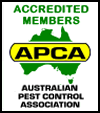Week 1 - Day 2 - Pesticides - Health & Safety
ESSENTIAL READING BEFORE COMMENCEMENT OF COURSE:
Urban
Pest Management in Australia: 2004
Edition, UNSW Press, Sydney
by
J Gerozisis and P Hadlington
- Chapter 7 - Pages 53 to 58;Chapter 8 - Pages 59 to 67.
Chapter 7 Pesticides – An Introduction – history of use of chemicals in pest control - definitions of pesticide - types of pesticides - government legislation - national registration scheme - specialist agencies - regulation and monitoring - chemical review - compliance and surveillance - pesticide labelling - signal heading - distinguishing name - active constituent - claims for use - contents - directions for use - restraints - ‘not to be used’ statement - other limitations or prohibitions - general instructions - precaution statements - storage and disposal - safety directions - first aid
Chapter 8 Insecticides – Main Types, Properties & Uses - brief history of insecticides - action of insecticides - routes of entry - dermal - oral - respiratory - modes of action - properties - toxicity - hazard - spectrum of activity - mammalian toxicity - persistence - volatility - repellency - flushing - knockdown - compatibility - phototoxicity - withholding period - insecticide resistance - types of insecticides - inorganic - botanical – organ-chlorines - organophosphates - carbamate - synthetic pyrethroids - insect growth regulators - hydroprene - methoprene - pyriproxifen - fenoxycarb - chitin synthesis inhibitors - triflumuron - hexaflumuron - diflubensuron - miscellaneous pesticides - fipronil - hydramethylnon - imidacloprid - fumigants
Commonly used pesticides:
In today’s modern society, it is hard to pin point
the most commonly used pesticides used around Australia,
and the facts and figures that can be acquired can only come
from the manufacturers. The most common group of pesticides
that are used by most well respected companies are synthetic
pyrethroids, the main reason is that they are safer for the
user the customer and the environment, given that they have
short lived residual. More of pesticides will be covered
and their history on the course.
Categories of pesticides - scheduled poisons:
The category of a pesticide or should we say the schedule
of a pesticide will vary dependent on the active constituent
or its formulation. This information is covered in what is
called the signal heading eg
Poisons Schedule |
Signal Heading |
Unscheduled |
Read Safety Directions
Before Opening Or Using |
LD50 ratio:
This is the standard of which how pesticides are measured
for their toxicity to humans. This is a statistical estimate
(based on test results) of the dose that, when administered
via a given route of entry, kills 50% of the test animals.
In basic terms a figure is given for toxicity, either oral
or dermal, and the higher the figure, the safer for humans,
the lower the figure the more dangerous for humans.
Government registration authorities:
In Australia, a system of product registration operates
for the purpose of control in order to avoid harmful effects.
The national Registration Authority for Agricultural and
Veterinary (Agvet) Chemicals.
Routes of entry into humans:
Insecticides may enter the insect body via the cuticle (dermal
entry), via the mouth (oral entry), or via the breathing
system (respiratory entry). A given insecticide may enter
primarily by one, two or by all three of these methods.
Storage of pesticides:
State regulations often dictate what is required in each
state, but basically the following rules should apply regardless
of state:
- Local fire fighting authorities should be advised of
the hazardous nature of the storage area.
- Should be remotely located from human dwellings
- Constructed of fire-resistant materials.
- Well ventilated
- Equipped with fire extinguishers
- Clearly labelled on the outside as to the hazardous nature
of the contents.
Clean up of pesticide spills:
This part of the course will deal with a recommended response
when or if you ever have a spill of chemical. A video will
be shown and a questionnaire will have to be answered at
the end to ensure you understand your immediate response
is a correct one, as you only get one chance when you have
a spill, to get it right.
Container disposal procedures:
Disposal of empty pesticide containers must be done safely.
- When a pesticide container is empty, triple rinse it
with water, and incorporate it with the spray being used
at the time.
- Always keep empty containers for disposal securely locked
in a pesticide storage facility.
- Aerosol containers must never be punctured or burnt.
- Render all empty containers once triple rinsed useless,
by puncturing them several times.
Useful websites:
|
